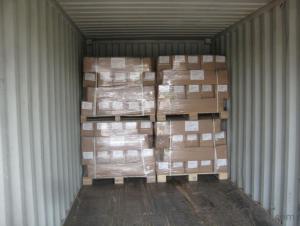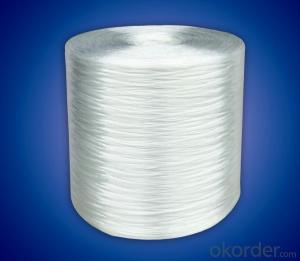China Fiberglass Roving E Fiber Glass Woven Roving Fabrics
- Loading Port:
- China Main Port
- Payment Terms:
- TT or LC
- Min Order Qty:
- 16000 kg
- Supply Capability:
- 16000Kg Per Month kg/month
OKorder Service Pledge
OKorder Financial Service
You Might Also Like
1.Brief Introduction
E-Glass Woven Rovings are bidirectional fabric made by interweaving direct rovings.
E-Glass Woven Rovings are compatible with unsaturated polyester, vinyl ester, epoxy and phenolic resins.
E-Glass Woven Rovings are a high-performance reinforcement widely used in hand lay up and robot processes to manufacture boats, vessels, plane and automotive parts, furniture and sports facilities.
2.Product Features
Warp and weft rovings aligned in a parallel and flat manner, resulting in uniform tension
Densely aligned fibers, resulting in high dimensional stability and making handling easy
Good moldability, fast and complete wet out in resins, resulting in high productivity
Good mechanical properties and high strength of parts
3.Product Specifications
Property | Area Weight | Moisture Content | Size Content | Width |
(%) | (%) | (%) | (mm) | |
Test Method | IS03374 | ISO3344 | ISO1887 | |
EWR200 | ±7.5 | ≤0.15 | 0.4-0.8 | 20-3000 |
EWR270 | ||||
EWR300 | ||||
EWR360 | ||||
EWR400 | ||||
EWR500 | ||||
EWR600 | ||||
EWR800 |
Special specification can be produce according to customer requirements.
4.FAQ
Packaging:
Each woven roving is wound onto a paper tube which has an inside diameter of 76mm and the mat roll has a diameter of 220mm. The woven roving roll is wrapped up with plastic film,and then packed in a cardboard box or wrapped up with kraft paper. The rolls can be horizontally placed. For transportation, the rolls can be loaded into a cantainer directly or on pallets.
Storage:
Unless otherwise specified,It should be stored in a dry, cool and rain-proof area. It is recommended that the room temperature and humidity should be always maintained at 15℃~35℃ and 35%~65% respectively.

- Q: What is the production process of FRP grille?
- Reciprocating fiber winding technology (belonging to the fixed length method): in this process, dipping tank with mandrel rotating reciprocating motion, long fiber glass fiber with a certain angle relative to the mandrel axis auxiliary, auxiliary angle (i.e. winding angle) by dipping groove movement speed and mandrel speed ratio control, control of electric glue impregnation groove translational motion by a computerized machine. The number of plies increases gradually to the wall thickness of the design. When the winding is finished, the resin in the product is basically solidified. After solidification, the core die is removed from the glass tube.
- Q: How to make a glass fiber reinforced plastic?
- The answer is no. The glass fiber reinforced plastic grille can be made with a mold, so it would be very easy to do it, while by manual, it would be troublesome, and do not have compressive property.
- Q: Materials of european component
- Polymer:.5%, the low alkalinity sulphoaluminate cement, forming perfectly, do not use additives which contain calcium chloride based. 2. It is anti-permeability. As the Portland cement, it can be formed at one time. 4, China requires that when using the ordinary portland cement, the zirconia's content do not less than 16, including alkali resistant glass fiber roving, white portland cement..5%:. 3. plasticizer: The fibers used in GRC must be alkali resistant glass fiber, fiber, early strength agent, alkali resistant glass fiber mesh and retarder. As the requirement of Europe and America, the content of zirconium oxide in glass fiber should be no less than 16: The acrylic emulsion is usually the polymer: We can add some of the volcanic ash active material selectively, that is, acrylic copolymerized emulsion. 5: We can select soft rubber mold, made by high temperature resin which suit the hard outer mold: High efficiency water and anti freezing agents reducing agent can be selectively added. That is conducive to comprehensive performance, enhance the durability of GRC products commonly. The cement can be hardening at fast speed. Sulphoaluminate cement /additives, alkali resistant glass fiber chopped yarn is easy demoulding.
- Q: What's the difference between g;ass reinforeced plastics and ordinary glass?
- Yes, P is a glass steel! The difference is that there are some differences between the materials of the antenna structure and the common vertical antenna, but the principle is the same.
- Q: How to produce glass steel?
- Material: Glass cloth, resin, curing agent tool: Glass?pane or polyester i thin?film process: According to the specifications for glass?reinforced?plastics, glass plane or polyester i thin film should be prepared and then you should tail glass cloth in accordance with requirements. At first, you should compound resin, and then you should put cloth that already have been tailed on the glass pane and cover it with compounded resin until its thickness meets requirements after removing all bubbles in it. After that, you should continue to cover it with polyester i thin film without bubbles and put a piece of glass on it if you want it more neat. A new product is ready after taking off the glass fiber reinforced plastics and trimming it carefully.
- Q: What parts must used fiber reinforced concrete?
- Dimensional concrete has high tensile strength and ultimate bending strength, or other importanter enginering part. Now many bridges uses prestressed concrete, especially the toughness increasing range is large, we rarely seen fiber reinforced concrete for bridges.
- Q: Method for repairing water leakage of toilet without knocking brick.
- Brick-changing is sure to be repaired, but we common people can not do well, maybe more bother. Not all of the leakage of water can follow repair methods bellow.
- Q: All about bamboo fiber.
- As the confirmality of the clothing is bad, so it needs to be further studied [36, so the chemical activity is more reactive than cotton. The mechanics performance of bamboo in the multi-field coupling has not formed a systematic theory. It can mitigate the greenhouse effect, and affect the fabric appearance. Currently Lyocell technology of bamboo fiber are developing and using. Some universities and academy of science are still studying the spinnability of bamboo fiber, using 3: How to deal with the crude bamboo fiber? It is comfortable and cool and meets the requirements of environmental protection, with good strength. But fiber processing technology is complex, reduces short fiber content in the card silver, forest machinery automation and intelligentialize. The bamboo fiber is divided into two categories. The method of fabric finish tectile dressing is better.
- Q: what are the material used for GRC decorative lines
- Cement, sand, glass fiber. We should pay attention to anti-cracking in interior decoration.
Send your message to us
China Fiberglass Roving E Fiber Glass Woven Roving Fabrics
- Loading Port:
- China Main Port
- Payment Terms:
- TT or LC
- Min Order Qty:
- 16000 kg
- Supply Capability:
- 16000Kg Per Month kg/month
OKorder Service Pledge
OKorder Financial Service
Similar products
Hot products
Hot Searches
Related keywords


























